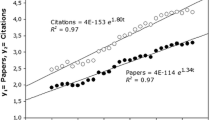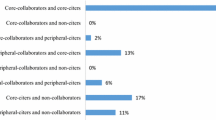Abstract
We obtained data of statistical significance to verify the intuitive impression that collaboration leads to higher impact. We selected eight scientific journals to analyze the correlations between the number of citations and the number of coauthors. For different journals, the single-authored articles always contained the lowest citations. The citations to those articles with fewer than five coauthors are lower than the average citations of the journal. We also provided a simple measurement to the value of authorship with regards to the increase number of citations. Compared to the citation distribution, similar but smaller fluctuations appeared in the coauthor distribution. Around 70% of the citations were accumulated in 30% of the papers, while 60% of the coauthors appeared in 40% of the papers. We find that predicting the citation number from the coauthor number can be more reliable than predicting the coauthor number from the citation number. For both citation distribution and coauthor distribution, the standard deviation is larger than the average value. We caution the use of such an unrepresentative average value. The average value can be biased significantly by extreme minority, and might not reflect the majority.





Similar content being viewed by others
References
Börner, K., et al. (2004). The simultaneous evolution of author and paper networks. Proceedings of the National Academy of Sciences of the United States of America, 101, 5266–5273.
Glänzel, W. (1996). Coauthorship patterns and trends in the sciences (1980–1998): A bibliometric study with implications for database indexing and search strategies. Library Trends, 50, 461–473.
Leimu, R., & Koricheva, J. (2005). Does scientific collaboration increase the impact of ecological articles? Bio Science, 55, 438–443.
Matia, K., et al. (2005). Scaling phenomena in the growth dynamics of scientific output. Journal of the American Society for Information Science and Technology, 56, 893–902.
Slone, M. (1996). Coauthors’ contributions to major papers publishedin the AJR: Frequency of undeserved authorship. American Journal of Roentgenology, 167, 571–579.
Tarnow, E. (1999). The authorship list in science: Junior physicists’ perceptions of who appears and why. Science and Engineering Ethics, 5, 73–88.
Tarnow, E. (2002). Coauthorship in physics. Science and Engineering Ethics, 8, 175–190.
van Raan, A. F. J. (2006). Statistical properties of bibliometric indicators: Research group indicator distributions and correlations. Journal of the American Society for Information Science and Technology, 57, 408–430.
Author information
Authors and Affiliations
Corresponding author
Rights and permissions
About this article
Cite this article
Hsu, Jw., Huang, Dw. Correlation between impact and collaboration. Scientometrics 86, 317–324 (2011). https://doi.org/10.1007/s11192-010-0265-x
Received:
Published:
Issue Date:
DOI: https://doi.org/10.1007/s11192-010-0265-x




